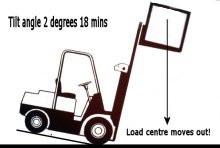Forklift Technical Information
The largest forklift operator training website in the world
![]()
![]()
Forklift Stability Testing - Longitudinal
There are three main organisations which lay down stability standards for fork lift trucks. In the UK we have the British Industrial Truck Association affectionately known as BITA. The European standards are promoted by FEM and the Japanese standards are maintained by JIVA. The capacity plate on the truck will mention one of these standards although they all use the same criteria.
There are four tests all of which involve placing the truck on a tilting platform but two of these are designed to test tipover at speed and are therefore dependant upon the trucks top speed. Only the two tests which do not rely on speed are described on this site. They are numbers one and three which test for longitudinal and lateral stability.
No 1 longitudinal stability testing (No 1 test)
 As mentioned, the truck is placed on a steel platform which can be tilted by means of hydraulic rams. The test states that the truck must have its full capacity load and it is normal to chain it to the forks and carriage in case things go wrong! In addition, the rear of the truck is chained to the platform with a chain that is left a little loose. The purpose of this is to prevent the whole thing tipping over during the test.
As mentioned, the truck is placed on a steel platform which can be tilted by means of hydraulic rams. The test states that the truck must have its full capacity load and it is normal to chain it to the forks and carriage in case things go wrong! In addition, the rear of the truck is chained to the platform with a chain that is left a little loose. The purpose of this is to prevent the whole thing tipping over during the test.
The truck is placed with its drive, (front), axle parallel to the hinge of the tilting platform and the mast is elevated to maximum height. It is this last point that makes the test a bit dramatic as it greatly increases the truck's effective load centre as can be seen in the drawing above.
The actual truck's load centre is defined as the dimension measured from the front face of the forks to the centre of gravity of the load and is usually either 500 mm (20"), or 600 mm (24"). The tilt that can be seen here does not actually alter the load centre in the sense that the load cannot move away from the forks as it is secured. The big problem is that the artificial tilt created in this test gives the same results as if the actual load centre were moved. This is compounded by the fact that the mast is fully elevated and the whole body of the truck is tilted. The platform must reach the angle shown, (just over 2 degrees), before the truck's rear wheels leave the floor in order for it to pass the test. This represents a slope of 4%.
If the truck attains this angle without tipping it is deemed to have passed the test. If you are an operator reading this, think about it the next time you hear someone telling you that you have a large safety factor of stability built in to your truck- YOU DON'T !!
Trucks are also tested for sideways or lateral stability and a description of this test is here